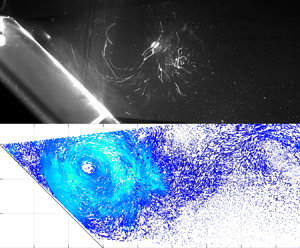Article contents
Interaction between breaking-induced vortices and near-bed structures. Part 1. Experimental and theoretical investigation
Published online by Cambridge University Press: 19 April 2022
Abstract

The present work describes the vortex–vortex interactions observed during laboratory experiments, where a single regular water wave is allowed to travel over a discontinuous rigid bed promoting the generation of both near-bed and surface vortices. While near-bed vortices are generated by the flow separation occurring at the bed discontinuity, surface vortices are induced by the wave breaking in conjunction with a breaking-induced jet. A ‘backward breaking’ (previously observed in the case of solitary waves) occurs at the air–water interface downstream of the discontinuity and generates a surface anticlockwise vortex that interacts with the near-bed clockwise vortex. With the vortex–vortex interaction influenced by many physical mechanisms, a point-vortex model, by which vortices evolve under both self-advection (in relation to both free surface and seabed) and mutual interaction, has been implemented to separately investigate the vortex- and wave-induced dynamics. The available data indicate that both self-advection and mutual interaction are the governing mechanisms for the downward motion of the surface vortex, with the effect of the breaking-induced jet being negligible. The same two mechanisms, combined with the mean flow, are responsible for the almost horizontal and oscillating path of the near-bed vortex. The investigation of the vortex paths allow us to group the performed tests into three distinct classes, each characterized by a specific range of wave nonlinearity. The time evolution of the main variables characterizing the vortices (e.g. circulation, kinetic energy, enstrophy, radius) and their maximum values increase with the wave nonlinearity, such dependences being described by synthetic best-fit formulas.
JFM classification
- Type
- JFM Papers
- Information
- Copyright
- © The Author(s), 2022. Published by Cambridge University Press
References
REFERENCES
- 3
- Cited by



